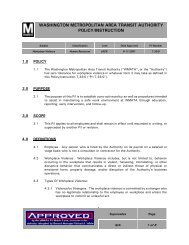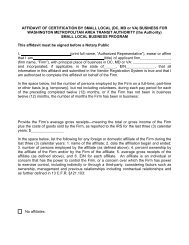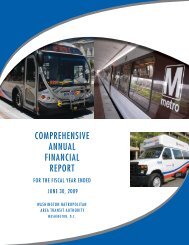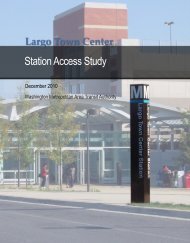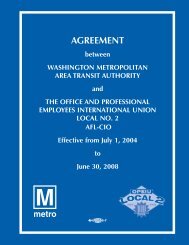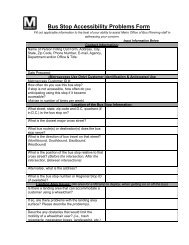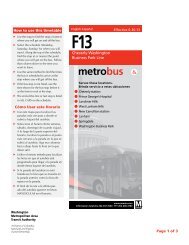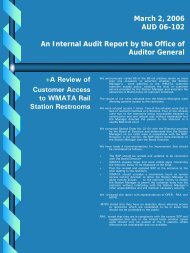Naylor Road Metro Station Area Access and Capacity - WMATA.com.
Naylor Road Metro Station Area Access and Capacity - WMATA.com.
Naylor Road Metro Station Area Access and Capacity - WMATA.com.
Create successful ePaper yourself
Turn your PDF publications into a flip-book with our unique Google optimized e-Paper software.
pedestrian signals, <strong>and</strong> sidewalks, <strong>and</strong> are among the busiest pedestrian crossings in the study<br />
area. When crossing Suitl<strong>and</strong> Parkway, pedestrians must cross right-turn slip lanes with large<br />
turning radii. Additional study-area intersections exhibit large turning radii, which allow<br />
motorists to turn at high speeds. Only the Branch Avenue <strong>and</strong> <strong>Naylor</strong> <strong>Road</strong> intersection features<br />
a push-button pedestrian countdown timer.<br />
<strong>Naylor</strong> <strong>Road</strong>’s roundabouts, in contrast, include crosswalks <strong>and</strong> ADA-<strong>com</strong>plaint curb ramps<br />
(Figure 19). While several <strong>Naylor</strong> <strong>Road</strong> intersections were upgraded a few years ago with<br />
prominent crosswalk striping, median refuges, <strong>and</strong> pedestrian signage, its pedestrian crossings<br />
continue to present safety issues. <strong>Station</strong> observations revealed that pedestrians frequently run<br />
across <strong>Naylor</strong> <strong>Road</strong> at designated crosswalks because the roundabouts fail to provide adequate<br />
breaks in heavy traffic.<br />
In addition, pedestrians continue to cross Branch Avenue midblock in the vicinity of the station<br />
entrance (Figure 20). The nearest marked crossing of Branch Avenue, located at the <strong>Naylor</strong> <strong>Road</strong><br />
intersection, is approximately 1,000 feet from Branch Avenue station entrance. Despite the lack<br />
of crosswalks or pedestrian signals, pedestrians cross Branch Avenue midblock because doing so<br />
can reduce travel time <strong>and</strong> thus increase convenience.<br />
Wayfinding Signage<br />
Pedestrian wayfinding signage surrounding <strong>Naylor</strong> <strong>Road</strong> <strong>Station</strong> is limited. Wayfinding sign<br />
designs range from small signs with a logo <strong>and</strong> arrow only, to large signs with arrows indicating<br />
where station facilities are located (Figure 21). All of these signs are oriented to motorists, not<br />
pedestrians, <strong>and</strong> lack information about points of interest within the local <strong>com</strong>munity.<br />
Figure 21: Existing Wayfinding Signage near <strong>Naylor</strong> <strong>Road</strong> <strong>Station</strong><br />
19 | Existing <strong>Station</strong> <strong>Area</strong> Characteristics





